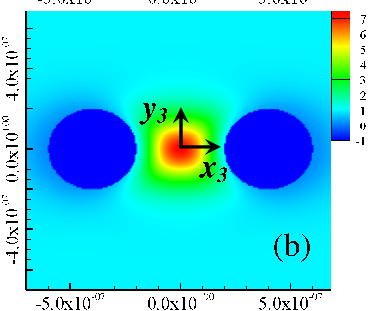Cooling of nanoparticles
The heat radiation emitted by a nanoparticle depends strongly on its environment.
As for the spontaneous emission of atoms, the heat radiated by a nanoparticle
changes tremendously when placing it close to a cold surface. This effect is
due to the near-field interaction between the nanoparticle and the surface.
This near-field interaction is sensitive to the geometry of the particle
(that is, whether its shape is rice corn-like or pancake-like) and to that of
the surface (also including surface roughness). In addition, it turns out that
many-particle effects (configurational resonances) affect the heat flux between
nanoparticles. For instance, the radiative heat flow between two nanoparticles
can be controlled (increased and decreased) by introducing a third nanoparticle,
due to such configurational resonances.

-
Svend-Age Biehs and Jean-Jacques Greffet:
Near-field radiative
heat transfer between a nanoparticle and a rough surface.
Phys. Rev. B 81, 245414 (2010).
arXiv:1103.2374v1
-
Oliver Huth, Felix Rüting, Svend-Age Biehs, and Martin Holthaus:
Shape-dependence of near-field heat
transfer between a spheroidal nanoparticle and a flat surface.
Eur. Phys. J. Appl. Phys. 50, 10603 (2010).
arXiv:1103.5039v1
-
Philippe Ben-Abdallah, Svend-Age Biehs, and Karl Joulain:
Many-body radiative heat
transfer theory.
Phys. Rev. Lett. 107, 114301 (2011).
arXiv:1107.3646v1
-
Maria Tschikin, Svend-Age Biehs, Philippe Ben-Abdallah, Felipe S. S. Rosa:
Radiative cooling of nanoparticles close to a surface.
Eur. Phys. J. B 85, 233 (2012).
arXiv:1112.3470v2


 Disclaimer
Disclaimer
 Druckversion
Druckversion
 Svend-Age Biehs; Last modified: Jul 11 2012
Svend-Age Biehs; Last modified: Jul 11 2012
